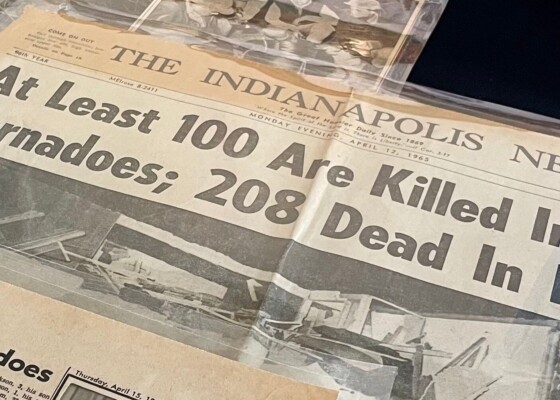Meltzer Woods: A Recap
June 7, 2017Tucked away in rural Shelbyville, Ind., is 60 acres of old growth forest–the only remaining in all Indiana, in fact. You wouldn’t know it was old growth to look at…
Tucked away in rural Shelbyville, Ind., is 60 acres of old growth forest–the only remaining in all Indiana, in fact. You wouldn’t know it was old growth to look at it. When we held our Next Indiana Campfires event there in April, I thought it didn’t seem terribly different from the forests I’d grown up playing in. But as we explored its history and considered some writing by well-known Indiana writers, I began to see that the forest held some fascinating lessons for visitors today.
The history of Meltzer Woods begins with the railroads, as one of our readings from Charles Deam, Indiana’s first state forester, indicates:
since there was a market for timber in the eastern States and in European countries, trees had an intrinsic value.
This gave a new impetus to settlement and commercial lumbering began. People soon learned that they could enter or buy a tract of land, sell of enough timber to erect a house and barn and to pay for the land. Saw mills were soon built every few miles along the railroads. It was soon learned that Indiana white oak, black walnut, yellow poplar, etc., were the best of their kind in the world. This reputation stimulated the demand so that the whole State was soon a network of railroads, carrying off our precious natural resource. The forests were converted into improved farms, which in turn built up many prosperous towns and cities. For years lumbering was the second industry of the State. The richness and early conversion of our forest resource soon placed Indiana among the leading States of the Union. (The Forests of Indiana, Past, Present, and Future, 1920)
Unintended consequences are a strange thing. Who could have predicted that expanding railroads would have led to the general deforestation of Indiana?
The other funny thing about unintended consequences is that it turns unexpected people into history makers. This was the case with the Meltzer family. They owned the local sawmill, and yet they were responsible for preserving the last piece of old growth forest in the entire state of Indiana. You can read more about the history here.
History puts us in strange positions, and individuals never know how they will need to respond. It is all the more important, then, that we have a clear sense of 1) how we talk about value and 2) what we owe to both the living and the dead. These were two questions I was thinking about when we hiked through Meltzer Woods in the middle of April. Literature in particular can help us find ways to think about these questions because our imaginations play an important role in picturing the past and future. Imagination also helps us picture the lived reality that our values can create.
I think these were some of the questions that Indiana poet Etheridge Knight had in mind when he was working on his poem “The Idea of Ancestry.” He writes:
Taped to the wall of my cell are 47 pictures: 47 black
faces: my father, mother, grandmothers (1 dead), grand
fathers (both dead), brothers, sisters, uncles, aunts,
cousins (1st & 2nd), nieces, and nephews. They stare
across the space at me sprawling on my bunk. I know
their dark eyes, they know mine. I know their style,
they know mine. I am all of them, they are all of me;
they are farmers, I am a thief, I am me, they are thee.
Later, he writes:
Each Fall the graves of my grandfathers call me, the brown
hills and red gullies of mississippi send out their electric
messages, galvanizing my genes.
His connection to the past is “electric”–a force that spurs him into action. When we got to this moment in our walk, I was picturing the Meltzers when they decided to not cut down their own forest. What spurred them to action? What electricity? Someone in our group mentioned that it was, apparently, an old German tradition for each family to have their own forest.
The Meltzers also had the privileged position of owning the sawmill, and so they benefited from other Hoosiers clearing their own forests. This paradox only confirms the almost esoteric workings of history. The Meltzers could have also cleared theirs, but in a strange way, I think working with the trees so intimately made them particular lovers of the forest. “Getting in the Wood,” a poem by Gary Snyder, gets at this paradox somewhat. It tracks the details of cutting down trees at an industrial pace, and yet one can’t help but feel the sense of unity that grows between the bodies of the workers and the bodies of the trees:
so the wedge springs off and tumbles
ringing like high-pitched bells
into the complex duff of twigs
poison oak, bark, sawdust,
shards of logs,
And the sweat drips down…
the young men throw splits on the piles
bodies hardening, learning the pace
and the smell of tools from this delve
in the winter
death-topple of elderly oak.
Four cords.
As our group read that poem, I was struck by the mention of “elderly”–which seemed particularly important since we were in an old growth forest. Our guide, Cliff Chapman, the Executive Director of the Central Indiana Land Trust, which maintains Meltzer Woods, pointed out that the important part of old growth isn’t the age of individual trees, but rather the collective age of the forest.
Thinking about that in conjunction with our poems, I began to think of the old growth forest as an image of society: the living trees are not necessarily ancient, but they carry an ancientness in their collectivity. In the same way, we humans have relatively short life spans, but we also carry the past with us, and that past often gives us a sense of how to measure value. History shaves away the ephemeral, and what we carry forward can be an important guide to considering value.
On the other hand, we have to recognize that questions of value are not entirely backwards looking as well. Knight’s poem serves as a guide for thinking through these questions again:
I have at one time or another been in love with my mother,
1 grandmother, 2 sisters, 2 aunts (1 went to the asylum),
and 5 cousins. I am now in love with a 7 year old niece
(she sends me letters written in large block print, and
her picture is the only one that smiles at me).
He loves his whole family, of course, but the object of his particular affections shifts toward the future. At another point, he even thinks about the possible sons he doesn’t have. The poem remarkably aware of both past and future in a way that is organic.
The Meltzers demonstrated a similar awareness: they recognized the value of the forest, its age and continuity. They knew this was something they valued and wanted to protect. But protection has an end: future generations. Something that Cliff Chapman brought up was that Meltzer Woods was there to be appreciated by the public also. It wasn’t like the wedding china that never comes out of the cupboard. Central Indiana Land Trust does important work in maintaining and protecting the Meltzer Woods, but it also does the important work of helping the public appreciate the value of the forest.
History puts folks in unique positions. And this trip reminded me of something important: now that I had seen Meltzer Woods, I was in a unique position as well. The Meltzers had played their part, and now that I knew about places like Meltzer Woods, I was in a similar position to ask the questions that the Meltzers had asked themselves:
- What value do I ascribe to places like Meltzer Woods?
- In light of that, what do I owe the dead and the future living? Specifically, what do I owe the Meltzers and future Hoosiers?
Perhaps one simple form of decision is donating to the Central Indiana Land Trust (which is responsible for conserving Meltzer Woods and places like it) or Indiana Humanities (which plays a role in helping us think through these kinds of questions).
Not all choices will look the same, but history is always knocking on our door and asking us to choose.
Next Indiana Campfires pairs nature and literature to ignite conversations about Indiana’s future. The program is supported by the Efroymson Family Fund, the Nina Mason Pulliam Charitable Trust and Pulitzer Prizes Centennial Campfires. Indiana Humanities is supported in part by Lilly Endowment Inc. and the National Endowment of the Humanities.
Join us for one of our upcoming outdoor adventures in 2017. We’ll be trekking through Fall Creek Woods in July, paddling the Eagle Creek Reservoir in August, and hiking the Tom and Jane Dustin Nature Preserve in October.


